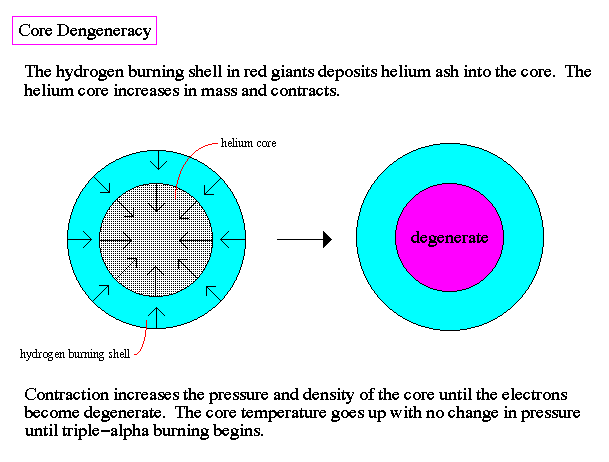
|
Red Giant Evolution:
| Readings: Schneider & Arny: Unit 64 |
| (Audio Lecture) |
A star's evolution after the red giant phase depends on its mass. For stars greater than 1 solar mass, but less than 2 solar masses, the hydrogen burning shell eats its way outward leaving behind more helium ash. As the helium piles up, the core becomes more massive and contracts. The contraction heats the core as it becomes more dense.
The density of the core increases to the point where the electrons and helium nuclei become degenerate. The core begins to act more like a liquid than a gas, and it becomes incompressible and further contraction stops.

As the hydrogen shell continues burning, the degenerate core grows hotter and hotter without expanding. Helium, being a larger nuclei than hydrogen, requires more kinetic energy to fuse, which means higher temperatures. At 100 million degrees, helium can be converted to carbon through the triple-α process.
Triple-α Process:
Energy generation is the key to the lifetime of a star. The proton-proton chain and the CNO cycle are the source of energy for main sequence stars, but as helium builds up in the core, the star must find another source of energy or it will die out. Fusion can occur between any nuclei if the motion of the nuclei is fast enough to overcome the electrostatic repulsion between the protons. For the waste product of the proton-proton chain or the CNO cycle, helium, there is twice the amount of electric charge (two protons) so it is twice as hard to fuse them compared to protons.

In the triple-α process, three He nuclei are fused to form carbon (technically, two He fuse first to form beryllium (Be), then beryllium and another He fuse to form carbon; but this happens so fast that Be only exists for a few microseconds). Carbon is the waste product plus energy in the form of gamma-ray photons.
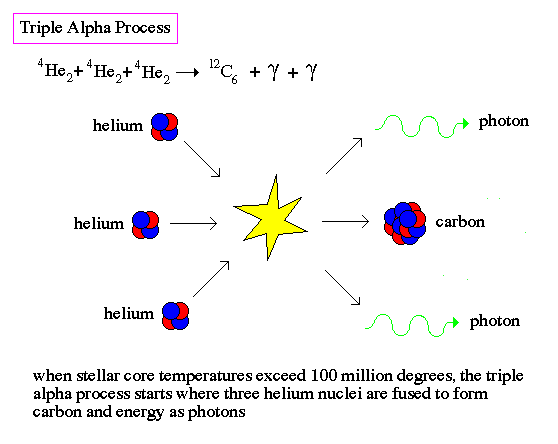
The energy released by the triple-α process continues to heat the core raising its temperature even more. Again, under normal circumstances, the heating would increase the pressure and the core would expand and cool. But, with the core being degenerate, the temperature goes up yet the core does not expand. Higher temperatures means a faster triple-α rate, which means more energy, which means higher temperatures, etc...
When the temperature of the core reaches 300 million degrees, a nearly explosive consumption of the helium takes place called the helium flash. During the very short helium flash (a few minutes), the star emits more energy than 100 times the output of the whole Galaxy. However, this energy never reaches the surface but instead goes into removing the degeneracy of the electrons and expanding the core.
For stars more than 2 solar masses, the triple-α process starts before the electrons become degenerate. And, so, there is no helium flash, just a gradual shift to a core helium burning region surrounded by a hydrogen burning shell.
Horizontal Branch Stars:
After helium burning begins (either explosively with a flash, or gradually for heavier stars), the star has two sources of energy, hydrogen fusion in a shell around the core and helium fusion in the core. Helium burns into carbon, and carbon combines with helium to make oxygen. The core of the star becomes rich in carbon and oxygen nuclei, and the star's surface temperature goes up to become a horizontal branch star.

Stars with masses greater than or equal to the Sun become smaller and hotter at a constant luminosity. They evolve to horizontal branch stars by moved across the HR diagram at constant brightness. Low mass stars at about 10 solar luminosities, high mass stars (10 solar masses) at about 200 solar luminosities. Notice that as they evolve, HB stars cross the instability strip. For a short time, high mass stars will be Cepheid variables and low mass stars will be RR Lyrae stars.
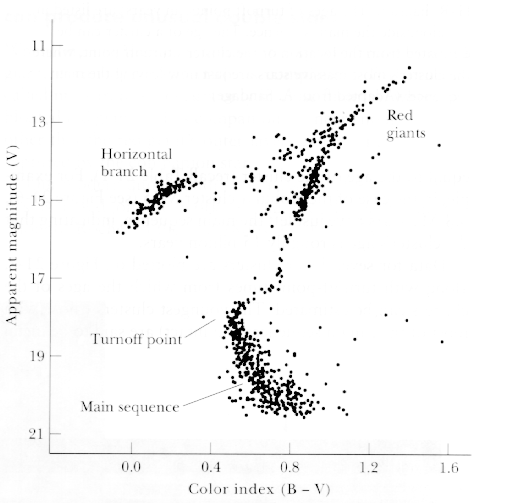
Asymptotic Giant Branch Stars:
After existing as horizontal branch stars for a few million years, the helium in the core of the star is exhausted (now being mostly carbon and oxygen nuclei) and a helium burning shell will develop underneath the hydrogen burning shell. The electrons and nuclei in the core again become degenerate and the star expands and cools to become an asymptotic giant branch star.
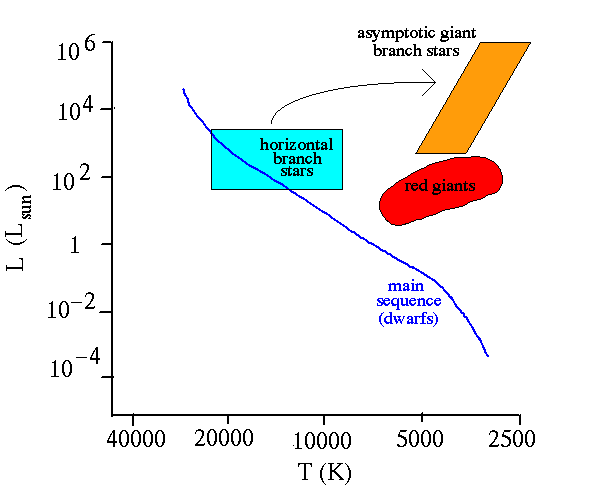
Most of the energy is coming from the hydrogen burning shell, the helium burning shell is small at this time. However, the hydrogen shell is dumping helium ash onto the helium shell. After sometime, enough helium is built up so that the helium shell undergoes an explosive event called a thermal pulse.

The thermal pulse is barely noticed at the surface of the star, but serves to increase the mass of the carbon/oxygen core, so that the size and luminosity of the star gradually increases with time. As the star climbs the asymptotic giant branch, a wind develops in the star's envelope which blows the outer layers into space. It is in this wind that dust particles (important for interstellar clouds and proto-solar systems) are formed from carbon material dredged up from the core by convective currents.

During this time, a thick dust shell blocks the visible light from the star such that even though it is 10,000 brighter than the Sun, it is only seen in the IR.
To summarize the evolution of a stellar core, the following figure shows the changes in a high mass star over time.
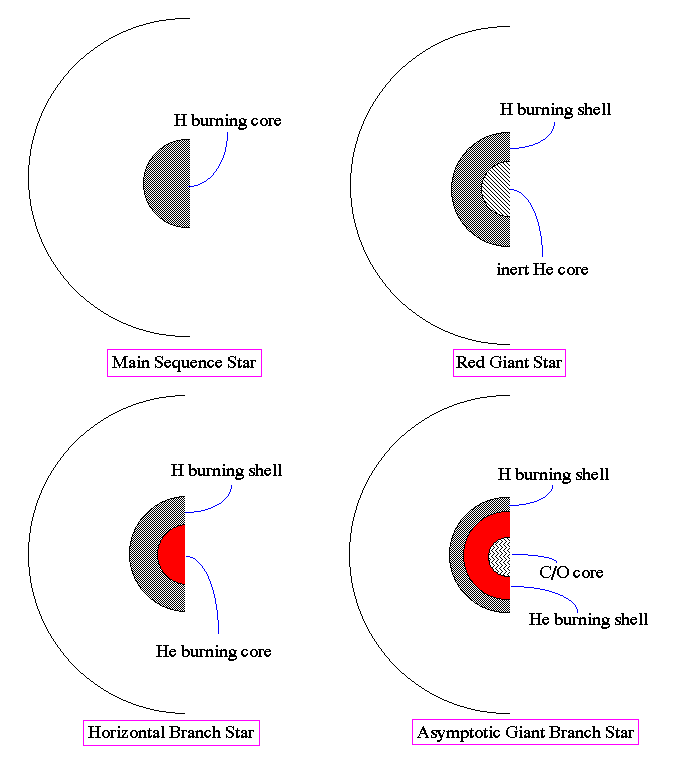
The stellar wind causes mass loss for AGB stars. This loss is around 10-4 solar masses per year, which means that in 10,000 years the typical star will dissolve, leaving the central, hot core (the central star in a planetary nebula). If the star is larger than 8 solar masses, then the core continues to heat. Carbon and oxygen fuse to form neon, then magnesium, then silicon. All forming into burning shells surrounding an iron ash core.
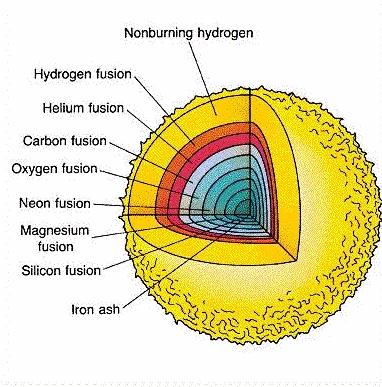
Iron is unusual in that it is extremely stable and resistant to fusion. The temperature of an iron core can reach 3 billion degrees. When the iron core reaches a critical mass, it collapses, violently, into a supernova explosion.

|
|

|